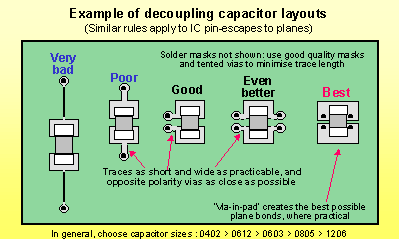I was reading through a few post including Decoupling caps as well as this app note Xilinx Power Distribution Network.
I have a question regarding capacitor values within a power distribution system. Unfortunately I believe that I have to give a bit of background before I can ask this question.
As stated in both the forum post and the app note the physical geometry of a capacitor dictates the self-inductance. In the case of decoupling the capacitor can be modeled as a small power supply with internal resistance, inductance and capacitance. In the frequency domain the view of the internal impedance of the capacitor is a "trough" where the beginning (zero) of the trough is dictated by the capacitance value and the end (pole) is from the parasitic-inductance. The lowest point of the trough is set by either the parasitic resistance or the lowest value of the resonance frequency of the LC combination of the capacitor / parasitic inductance value (whichever produces a higher impedance).
The following is an image illustrating the characteristics of a capacitor

here is the equation for the resonance frequency. $$ \frac{1}{2\pi \sqrt{L \times C}} $$ -Thanks for catching that Olin
By this reasoning one can choose the largest size capacitor in the given package size, for example 0402, and the properties of the pole will not change and only the zero will be moved to a lower frequency (in the image, the downward slope would be moved to the left for large capacitor values) allowing a wider bandwidths of frequency to be bypassed. The resonant pole that defines the upper portion of the capacitor should encompass any higher value capacitor of the same package size.
Later on in the app note there is a section called "Capacitor Placement" where, as described in Olin's response, the effectiveness of the capacitor doesn't just concern the inductance of the cap, but also has to do with the placement of the cap. In colloquial terms the problem is this: As an IC begins to draw more power the voltage begins to sag, the time it takes for that sag to be seen by the decoupling capacitor is determined by the propagation speed of the material that the signal (voltage drop) must travel, basically closer is better. An example is done within the app note which is as follows
0.001uF X7R ceramic chip capacitor, 0402 package Lis = 1.6 nH (theoretical inductance of both parasitic self-inductance, and board inductance)
The resonance frequency at which the capacitor has the lowest impedance is given as $$ Fris = \frac{1}{2\pi \sqrt{L \times C}} $$ $$ Fris = \frac{1}{2\pi \sqrt{1.6\times10^-9 \times 0.001\times10^-6}} = 125.8MHz $$
The period of this frequency is Tris
$$ Tris = \frac{1}{Fris} $$ $$ Tris = \frac{1}{125.8\times10^6} = 7.95ns$$
In order for a capacitor to be effective it needs to be able to respond faster than the voltage can sag on a pin. If the voltage sag were to happen faster than 7.95ns than there would be some time between the dip on the pin and the capacitors capability to respond to that dip manifesting in voltage spikes the can possible drop the voltage down to a point of brown out, or reset. In order for the capacitor to remain effective the voltage change must happen at a slower rate then some fraction of the resonant period (Tris). To quantize this statement an accepted effective response time of a capacitor is 1/40th of the resonance frequency, so the effective frequency of this capacitor is really
$$ Effective Fris = \frac{125.8\times10^6}{40} = 3.145MHz $$
or the capacitor will be able to cover a dip that occurs over a .318uS period.
$$ Effective Tris = \frac{1}{3.145\times10^6} = .318us $$
Unfortunately a capacitor cannot usually be placed on top of a pin so there is another delay contributed by the material the PCB is composed of. This delay can be modeled as a propagation speed of the material. In the app note the propagation speed of a standard FR4 dielectric is 166ps per inch.
Using the effective resonance period (Tris) from above and the propagation speed of the material we can find the distance at which the capacitor remains effective at the Effective Fris.
$$ Distance(x) = \frac{time(t)}{speed(\frac{t}{x})} $$ $$ Distance(x) = \frac{.318\times10^-6}{1.66\times10^-12} = 1.20in$$ or about 3.0cm
Finally I can ask my question!
Since the package size is the part of the cap that mitigates the pole or the upper bound of the impedance of the modeled power supply, then it shouldn't matter if I were to use a 0.001uF cap 0402 package, or a 0.47uF capacitor 0402 package. A better method to determine the Fris of the cap is to find the frequency at which either the internal resistance or the effective capacitance intersects with the pole (whichever point is higher). Is this correct? or is there some other factor that I have not taken into consideration?

